Omega SA
 | |
| Privately held company | |
| Industry | Watch manufacturing |
| Founded | 1903 |
| Founder | Louis Brandt |
| Headquarters | Biel/Bienne, Switzerland |
Key people | Raynald Aeschlimann, President |
| Products | Watches |
| Parent | The Swatch Group |
| Website | omegawatches.com |
Omega SA is a Swiss luxury watchmaker based in Biel/Bienne, Switzerland. Formally operating as the La Generale Watch Co, founded in 1848, later incorporating the name Omega in 1903. Britain's Royal Flying Corps chose Omega watches in 1917 as its official timekeepers for its combat units, as did the U.S. Army in 1918. Omega watches were the choice of NASA and the first watch on the Moon in 1969.[1] Omega has been the official timekeeping device of the Olympic Games since 1932.[2] James Bond has worn it in films since 1995; other famous Omega wearers, past and present, include Elvis Presley, John F. Kennedy,[3] Prince William, George Clooney and Buzz Aldrin.[4] Omega is owned by the Swatch Group.
History
Founding

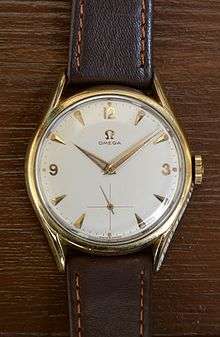
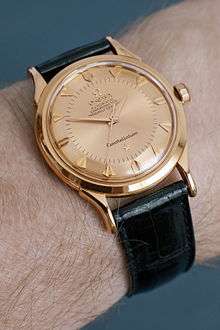
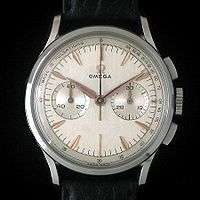
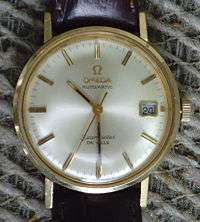
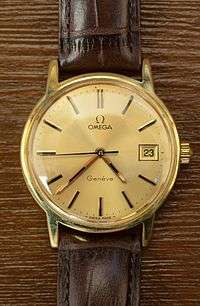
The forerunner of Omega, La Generale Watch Co, was founded at La Chaux-de-Fonds, Switzerland in 1848[5] by Louis Brandt, who assembled key-wound precision pocket watches from parts supplied by local craftsmen. He sold his watches from Italy to Scandinavia by way of England, his chief market. In 1894, his two sons Louis-Paul and César developed a revolutionary in-house manufacturing and total production control system that allowed component parts to be interchangeable. Watches developed with these techniques were marketed under the Omega brand of La Generale Watch Co. By 1903 the success of the Omega brand led to La Generale Watch Co to spin off the Omega brand as its own company, and the Omega Watch Co was officially founded in 1903.
Merger
Louis-Paul and César Brandt both died in 1903, leaving one of Switzerland's largest watch companies — with 240,000 watches produced annually and employing 800 people — in the hands of four young people, the oldest of whom, Paul-Emile Brandt, was not yet 24.
Brandt was the great architect and builder of Omega.[6] His influence would be felt over the next half-century. The economic difficulties brought on by the First World War would lead him to work actively from 1925 toward the union of Omega and Tissot, then to their merger in 1930 into the group SSIH, Geneva.
Under Brandt's leadership and Joseph Reiser's from 1955, the SSIH Group continued to grow and multiply, absorbing or creating some fifty companies, including Lanco and Lemania, manufacturer of the most famous Omega chronograph movements. By the 1970s, SSIH had become Switzerland's number one producer of finished watches and number three in the world. Up to this time, the Omega brand outsold Rolex, its main Swiss rival in the luxury watch segment, although Rolex watches sold at a higher price point. Around this time it was viewed as Rolex versus Omega in the competition for the "King of Swiss Watch brands". Omega watches tended to be more revolutionary and more professional focused, while Rolex watches were more ‘evolutionary’ and famous for their mechanical pieces and brand.[7][8][9]
While Omega and Rolex had dominated in the pre-quartz era, this changed in the 1970s. That was when Japanese watch manufacturers such as Seiko and Citizen rose to dominance due to their pioneering of quartz movement. In response, Rolex continued concentrating on its expensive mechanical chronometers where its expertise lay (though it did have some experimentation in quartz), while Omega tried to compete with the Japanese in the quartz watch market with Swiss made quartz movements.[7][10]
Financial takeover
Weakened by the severe monetary crisis and recession of 1975 to 1980, SSIH was bailed out by the banks in 1981.[11] During this period, Seiko expressed interest in acquiring Omega, but nothing came out of the talks.
Switzerland's other watch making giant Allgemeine Schweizerische Uhrenindustrie AG (ASUAG - supplier of a large range of Swiss movements and watch assemblers) was in economic difficulty. It was the principal manufacturer of Ébauche (unfinished movements) and owner, through their sub-holding company General Watch Co (GWC), of various other Swiss watch brands including Longines, Rado, Certina, Hamilton Watch Company and Mido.
After drastic financial restructuring, the R&D departments of ASUAG and SSIH merged production operations at the ETA complex in Granges. The two companies completely merged forming ASUAG-SSIH, a holding company, in 1983.
Two years later this holding company was taken over by a group of private investors led by Nicolas Hayek. Renamed SMH, Société de Microélectronique et d'Horlogerie, this new group over the next decade proceeded to become one of the top watch producers in the world.[12] In 1998 it became the Swatch Group, which now manufactures Omega and other brands such as Blancpain, Swatch, and Breguet.
Omega's brand experienced a resurgence with advertisement that focused on product placement strategies, such as in the James Bond 007 films; the character had previously worn a Rolex Submariner but switched to the Omega Seamaster Diver 300M with GoldenEye (1995) and has stayed with the latter ever since until swapping it for the Omega Planet Ocean and Aqua Terra. Omega also adopted many elements of Rolex's business model (i.e. premium pricing, tighter controls of dealer pricing, increasing advertising, etc.) which was successful in increasing Omega's market share and name recognition to become more of a direct competitor to Rolex.[7][13][14]
Observatory Trials
Observatory trials focused on the science of Chronometry and the ability to make chronometers measure time precisely. Only Patek Philippe and Omega participated every year in the trials. Omega's performances at these competitions garnered the company a reputation of precision and innovation.[15]
For more than a decade (1958 – 1969), Omega was the largest manufacturer of COSC chronometers. Omega developed the slogan "Omega – Exact time for life" in 1931 based on historical performance at the Observatory trials. Omega's early prowess in designing and regulating timing movements was made possible by the company's incorporation of new chronometric innovations.[15]
Important reference dates for the Omega precision records:[15]
- 1894: Creation of the famous 19 caliber named Omega. The company is renamed after this famous caliber in 1903[16] from 'Louis Brandt et Frères'. Omega participates for the first time at observatory trials in Neuenburg (French: Neuchâtel). Albert Willemin, the first "regleur de précision" at Omega, regulated the movement.
- 1911: Albert Willemin leaves Omega and is replaced by Werner-A. Dubois.
- 1918: Werner-A. Dubois leaves Omega (he joins Paul Ditisheim) and is replaced by Carl Billeter.
- 1919: 1st Prize at observatory trials in Neuenburg with a 21 caliber. This caliber was slightly modified to become the famous Cal. 47.7 later.
- 1920: Gottlob Ith replaces Carl Billeter.
- 1922: Omega participates for the first time at observatory trials in Kew-Teddington (achieved 3rd place).
- 1925: 1st place at observatory trials in Kew-Teddington with a Cal. 47.7 (95.9 of 100 points ex aequo with Ulysse Nardin); Gottlob Ith regulated the movement.
- 1929: Alfred Jaccard joined Omega.
- 1930: 1st place at observatory trials in Kew-Teddington (96.3 of 100 points ex aequo with Movado); Alfred Jaccard regulated the movement.
- 1931: Omega achieves 1st place in all 6 categories at observatory trials in Geneva; Alfred Jaccard regulated the movements.
- 1932: Introduction of the first small wrist Chronograph the Omega 28.9 chronograph
- 1933: A Cal. 47.7 regulated by Alfred Jaccard achieved the precision record at observatory trials. Kew-Teddington; 97.4 points of 100.
- 1936: Another Cal. 47.7 regulated by Alfred Jaccard achieved the precision record of 97.8 points of 100. Kew-Teddington. This record was not broken until as late as 1965.
- 1937: 1st place at Kew-Teddington with 97.3 points.
- 1938: 1st place at Kew-Teddington with 97.7 points.
- 1939: Creation of the Cal. 30 (the first 30mm caliber).
- 1940: 1st place with Cal. 30mm at Kew Teddington; movement regulated by Alfred Jaccard.
- 1943: Launch of the 30mm caliber 30T2 (first rose gold-plated Omega movement).
- 1945: 1st place with 30mm caliber at the observatory in Geneva; movement regulated by Alfred Jaccard.
- 1947: Creation of the first Omega tourbillon wristwatch movement (Cal. 30I). Specially developed for the observatory trials (only 12 pieces made).
- 1948: 1st place at observatory trial in Neuenburg for 30mm caliber. 1st time non-Swiss companies allowed to take part.
- 1950: 1st place for tourbillon Cal. 30I at Geneva Trials; regulated by Alfred Jaccard. Joseph Ory joins precision timing department after being Trainer to women timers (regleuse).
- 1951/2:1st place at the observatory trials in Geneva.
- 1953: Alfred Jaccard died.
- 1954: New record in Geneva by Gottlob Ith.
- 1955: Two new records at Neuenburg by Gottlob Ith.
- 1956: Gottlob Ith died aged 66 years; Joseph Ory takes over as head of department. Two 1st places at observatory trials in Neuenburg.
- 1958: New record in Geneva movements regulated by Joseph Ory. Creation of competition Cal. 30GD – a 30mm caliber with better mainspring and higher frequency (25,200 instead of 18,000 vph). This unusual frequency is used again today for the latest coaxial movements.
- 1959: Two records in Neuenburg and one new record in Geneva; movements regulated by Joseph Ory.
- 1960: One new record in Geneva, One new record in Neuenburg and also 1st place in Neuenburg. Movements regulated by Joseph Ory.
- 1961: Two new records in Geneva by Joseph Ory. The first four places for the 'single pieces' category in Geneva are occupied by Omega.
- 1962: 2nd, 3rd and 4th places for Omega, which decides to create a new caliber.
- 1963: Two 1st places in Geneva and Neuenburg. Movements regulated by Joseph Ory and André Brielmann.
- 1964: New record in Neuchatel by Joseph Ory.
- 1965: Omega occupies 2nd to 9th places (1st place goes to Zenith). Pierre Chopard was tasked to create a new Caliber for the observatory trials. Cal. E11 had a very unusual shape to take a very big barrel and its mainspring. It never entered competition because quartz movements arrived in 1967.
- 1966: Three new records for Omega (two in Neuenburg, one in Geneva).
- 1967: Quartz movement Beta 1 (later Beta 21) included in the same category as mechanical movements. Last year that Omega competed with mechanical movements as "old technology" not comparable with quartz. The production watch was released in 1970 as the Omega Electroquartz accurate to 5 seconds per month
- 1968: Omega enters with a tuning fork movement regulated by André Brielmann for a new record.
- 1969: Two new records for the tuning fork movements regulated by André Brielmann.
- 1970: One new record for the tuning fork movement regulated by André Brielmann.
- 1971: Two new records for the tuning fork movements regulated by André Brielmann.
- 1972: André Brielmann retires.
- 1974: Omega Marine Chronometer certified as the world first Marine Chronometer wristwatch, accurate to 12 seconds per year
Movements and the coaxial escapement
In 1947, Omega created the first tourbillon wristwatch calibre in the world with the 30I. Twelve of these movements were made, intended for inclusion in the observatory trials in Geneva, Neuchâtel and Kew-Teddington, and they were known as the Omega Observatory Tourbillons. Unlike conventional Tourbillion movement's whose cages rotate once per minute, the 30I's cage rotated one time each seven and a half minutes. In 1949, one of these delivered the best results ever recorded by a wristwatch up to that time. A year later, Omega broke its own record in the Geneva Observatory Trials of 1950.[17]
In 1999, after the successful development of Calibre 2500,[18] Omega made history by introducing the first mass-produced watch incorporating the coaxial escapement — invented by English watchmaker George Daniels. Considered by many[19] to be one of the more significant horological advances since the invention of the lever escapement, the coaxial escapement functions with virtually no lubrication, thereby eliminating one of the shortcomings of the traditional lever escapement. Through using radial friction instead of sliding friction at the impulse surfaces the coaxial escapement significantly reduces friction, theoretically resulting in longer service intervals and greater accuracy over time.[20]
On January 24, 2007 Omega unveiled its new Calibres 8500[21] and 8501, two coaxial (25,200 bph) movements created exclusively from inception by Omega.[22]
On January 17, 2013 Omega announced the creation of the world's first movement that is resistant to magnetic fields greater than 1.5 tesla (15,000 gauss), far exceeding the levels of magnetic resistance achieved by any previous movement - a similar movement was used by Daniel Craig as James Bond, though the official collectors watch was labelled as resistant to 15,007 gauss in honor of the fictional secret agent's codename. Most anti-magnetic watches utilize a soft iron - Faraday cage which distributes electromagnetism in such a way that it cancels the effect on the movement contained within. Omega has instead built a movement of non-ferrous materials eliminating the need for such a cage and providing a far greater resistance to magnetic fields.[23]
Omega watches in space exploration
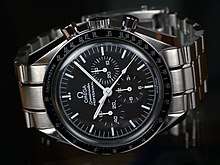
The selection of the "Omega Speedmaster Professional Chronograph" for American astronauts was the subject of a rivalry between Omega and Bulova.[24]
All subsequent manned NASA missions also used this handwound wristwatch. NASA started selecting the chronograph in the early 1960s. Automatic chronograph wristwatches were not available until 1969. Even so, all the instrument panel clocks and time-keeping mechanisms in the spacecraft on those space missions were Bulova Accutrons with tuning fork movements, because at the time NASA did not know how well a mechanical movement would work in zero gravity.
First watch on the moon
The Omega Speedmaster Professional Chronograph was the first watch on the Moon, worn by Buzz Aldrin. Although Apollo 11 commander Neil Armstrong was first to set foot on the moon, he left his 105.012 Speedmaster inside the Lunar Module as a backup because the LM's electronic timer had malfunctioned. Aldrin elected to wear his and so his Speedmaster became the first watch to be worn on the moon. Armstrong's watch is now displayed at the National Air and Space Museum in Washington, D.C.[25] Aldrin's was lost. He mentions in his book, Return to Earth, that when donating several items to the Smithsonian Institution, his Omega was one of the few things that was stolen from his personal effects.[26]
In 2007, to mark the 50th anniversary of the Omega Speedmaster Professional Chronograph, the Omega company unveiled the commemorative Speedmaster Professional Chronograph Moonwatch. The watch had the distinctive features of the first hand-winding Omega Speedmaster introduced in 1957. It was sold in an edition of 1,957.[27]
Notable owners
Omega sponsors a number of celebrities to wear and advertise their watches including:[28]
- Buzz Aldrin, astronaut
- Pierce Brosnan, actor; fictional character James Bond[29]
- Eugene Cernan, astronaut[30]
- Jeremy Clarkson, television personality
- George Clooney, actor[31]
- Jacques Cousteau, oceanographer; Omega Marine Chronometer
- Daniel Craig, actor; fictional character James Bond
- Cindy Crawford, model[32]
- David Duchovny, actor; fictional character Fox Mulder
- Sergio García, golfer
- Chris Hadfield, astronaut
- Richard Hammond, television personality
- Nicole Kidman, actress[33]
- Davis Love III, golfer[34]
- Tom Marshburn, astronaut
- James May, television personality
- Greg Norman, golfer
- Michael Phelps, swimmer; Olympic champion[35]
- Rajinikanth, actor
- Eric Tabarly, yachtsman; Omega Marine Chronometer
- Michelle Wie, golfer
- Zhang Ziyi, actress[36]
In addition, the following have been seen wearing Omega watches:
- Gianni Agnelli, former head of FIAT and Italian industrialist, wore an Omega Seamaster Ploprof.
- Stone Cold Steve Austin, American film and television actor, producer, and retired professional wrestler, wears an Omega Seamaster Professional Chronograph and is an avid watch collector/enthusiast.[37]
- Joe Biden, the former vice president of the United States of America, wore a blue Omega Seamaster Professional 300M Quartz.[38]
- Alton Brown, television personality
- Jeremy Clarkson, English journalist, broadcaster and former presenter of motoring television show Top Gear, wears a Seamaster Planet Ocean and a Seamaster Professional 300M.
- Mikhail Gorbachev, former president of the Soviet Union, wore a gold Omega Constellation "Manhattan".[39]
- Tom Hanks, American actor, producer, writer, and director, wears an Omega Speedmaster Professional.[40]
- Jack Hanna, American zookeeper and the Director Emeritus of the Columbus Zoo and Aquarium, wears an Omega Seamaster Professional.[41]
- John F. Kennedy[42]
- Mao Zedong, the founding father of the People's Republic of China, wore an Omega for 31 years.[43]
- Reinhold Messner, mountaineer, adventurer, and explorer, wore an Omega Speedmaster Professional.[44]
- Elvis Presley, American singer, actor, cultural icon, and one of the most popular musicians of the 20th century, wore a black-dialed Constellation Calendar.[45]. Most notably, a 1960 Omega watch gifted to him by RCA Records to celebrate his sale of 75-million records and retailed by Tiffany & Co was auctioned on May 12, 2018, at Phillips in Geneva for $1,812,500, including fees. It is, to this date, the highest price ever paid for an Omega watch. Mr. Petros Protopapas, Omega's Museum Director, and who attended the auction, later confirmed the Museum he heads to have been the winning bidder.
- Adam Savage, American special effects designer, co-host of The Discovery Channel television series MythBusters, wears a Seamaster Planet Ocean Chronograph given to him by his wife.[46]
- Prince William wears an Omega Seamaster 300M Quartz which was a gift from his late mother, Diana Princess of Wales.[47]
- T. E. Lawrence owned an Omega pilot's watch. This watch was purchased at an antiques stall in Wales with a service receipt made out in the name of Lawrence's pseudonym, "T. E. Shaw". The owner appeared on an episode of Antiques Roadshow in 2000, at which time it was given a value of £10,000.[48]. A later episode revealed that it had been purchased by the Omega Museum in Biel/Bienne.
Sponsorship, product placement, advertising, and sport
NCIS
In the US television series NCIS, lead actor Mark Harmon wears an Omega Seamaster Planet Ocean with supporting cast member Michael Weatherly wearing a matching version. In both cases, this is the stainless steel model with orange bezel and black dial.
Need For Speed
Omega is the official timekeeper for the video game Need for Speed II, released on Microsoft Windows and PlayStation in 1997.[49]
Kojak
In the US television series Kojak, lead actor Telly Savalas wore a gold-plated Omega Time Computer One, the first mass-produced LED watch.
James Bond
Omega has been associated with James Bond movies since 1995. That year, Pierce Brosnan took over the role of James Bond and began wearing the Omega Seamaster Quartz Professional (model 2541.80.00) in the movie GoldenEye. In all later films, Brosnan wore an Omega Seamaster Professional Chronometer (model 2531.80.00). The producers wanted to update the image of the fictional "super-spy" to a more distinctly sophisticated "Euro" look.[50]
Another possible reason for the change from the Rolex Submariner that Bond had previously worn was a change in the business environment surrounding modern films and product placement. Omega was eager to participate in high-profile co-promotions/product placement opportunities, especially the James Bond franchise, to further its brand image/awareness. It accomplished this by supplying products and finance (something that the conservative Rolex company avoids, presumably because it sees no benefit for itself).[51]
For the 40th anniversary of James Bond (2002) a commemorative edition of the watch was made available model 2537.80.00 (10,007 units). The watch is identical to the model 2531.80.00 except the blue watch dial had a 007 logo inscribed across it and also machined into the caseback. The band also had 007 inscribed on the clasp.[52]
Daniel Craig, the current James Bond since Casino Royale, also wears the Omega Seamaster: the Seamaster Planet Ocean (model 2900.50.91) in the first part of Casino Royale, and the Seamaster Professional 300M (model 2220.80.00) in the latter part (from travelling to Montenegro). He even goes so far as to mention Omega by name when questioned by Vesper Lynd. In connection with the launch of the film, Omega released in 2006 an 007-special of the Professional 300M, (model 2226.80.00) featuring the 007-gun logo on the second hand and the rifle pattern on the watch face, this being a stylized representation of the gun barrel sequence of Bond movies.[53]
Omega released a second James Bond limited edition watch in 2006. This was a Seamaster Planet Ocean model with a limited production of 5007 units. The model is similar to what Craig wears earlier on in the film; however, it has a small orange colored 007 logo on the second hand, an engraved caseback signifying the Bond connection, and an engraved 007 on the clasp.[54]
In the 2008 movie Quantum of Solace, Craig wears the Omega Seamaster Planet Ocean with a black face and steel bracelet (42mm version). Another limited edition was released featuring the checkered "PPK grip" face with the Quantum of Solace logo over it.[55] The third limited edition release from Omega came in 2012. This model was based on the Planet Ocean Ref: 232.30.42.21.01.004. It featured a textured dial with the 007 logo at the 7 o'clock position, and a 007 decorated rotor visible through the case-back.[56]
In 2015 two commemorative models were produced for the 24th Bond film, Spectre: the Omega Seamaster 300m master co-axial Ref: 233.32.41.21.01.001. 7007 units were produced, and came with a NATO strap as well as the standard bracelet. The watch also featured a bi-directional bezel with a world timing scale rather than a diving scale present on the standard 300m.[57] The second timepiece for the film was the Omega Seamaster Aqua Terra 150m master co-axial Ref: 231.10.42.21.03.004. The watch was decorated with a textured dial based on the Bond family coat of arms, as well as with a rotor resembling a bullet and gun barrel with "James Bond" inscribed.[58]
Sports sponsorship
Omega has frequently been the official timekeeper for the Olympics, beginning with the 1932 Summer Olympics. It was the official timekeeper for the 2006 Winter Olympics, 2008 Summer Olympics, and 2010 Winter Olympics.[59] In 2008, Omega brought out an Olympic edition with its logo on the second hand. Olympic swimmer and multiple gold medalist Michael Phelps is an Omega Ambassador and wears the Seamaster Planet Ocean. Omega is also the official timekeeper for the 2012 Summer Olympic Games.[60] In 2014 Omega became the official timekeeper of the 2014 Sochi Winter Olympic Games. The brand was a Worldwide Olympic Partner at the 2016 Summer Olympics.
Providing support to Emirates Team New Zealand and representing the team's official watch, in 2007 Omega introduced the Seamaster NZL-32 chronograph, with the name suggested by the name of the boat that won the America's Cup in 1995. The watch was developed in cooperation with Dean Barker, skipper of Team New Zealand and Omega Ambassador.[61]
On July 1, 2011 Omega became the official timekeeper of PGA of America through the signing of a five-year agreement that was to carry through 2016. The brand also sponsors the Dubai Desert Classic and the Omega European Masters.
Watch models

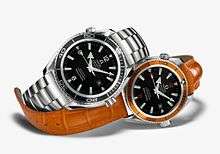
For men
Current models:[62]
- Constellation
- Omega Seamaster
- Includes the Planet Ocean, Ploprof, Aqua Terra, Bullhead, and Seamaster Bond Styles
- Omega Speedmaster
- Includes the Omega Speedmaster Professional Moon watch
- De Ville
- Specialties
- The 1957 Trilogy
- Railmaster '57
- Seamaster '57
- Speedmaster '57
- The 1957 Trilogy
Discontinued models:[63]
- Flightmaster
- Dynamic (1997)
- Geneve (1979)
- Ranchero (1976)
For women
Current models:[64]
- Constellation
- Seamaster
- Speedmaster
- De Ville
- Specialities
See also
References
- ↑ Bailham, Lee; Eric Jones. "Omega Speedmaster Professional Chronographs". NASA. Retrieved 21 April 2012.
- ↑ "Highlights of Olympic Timekeeping". Omega SA. Archived from the original on 17 April 2012. Retrieved 21 April 2012.
- ↑ "オメガ・ウォッチ: JFK's Omega Wristwatch acquired for the Omega Museum". オメガ・ウォッチ. Retrieved 22 March 2015.
- ↑ "OMEGA Watches: Planet OMEGA". OMEGA Watches. Retrieved 22 March 2015.
- ↑ "Omega: the first 100 years".
- ↑ Richon, Marco. 2007 Omega: A Journey through Time.
- 1 2 3 papajon on October 31, 2010 · 5 Comments (2010-10-31). "Rolex Vs Omega: A Brief History of Two Great Watch Brands". Swiss Watch Guide. Retrieved 2013-02-21.
- ↑ "Comparative Review of the Omega Seamaster Professional Model2254.50.00 VS. The Rolex Submariner 16610 | Luxury Tyme: The Rolex Reference Page". Luxury Tyme. Retrieved 2011-12-31.
- ↑ "Comparative Review of the Rolex Sea-Dweller VS. Omega Planet Ocean". The Seamaster Reference Page. 2010-08-03. Retrieved 2011-12-31.
- ↑ Expert Author (2011-01-08). "Rolex vs. Omega; The Rivalry Goes On". Yourexpertarticles.com. Retrieved 2011-12-31.
- ↑ Conklin, David W. (2006). Cases in the Environment of Business: International Perspectives. SAGE. ISBN 9781412914369.
- ↑ According to the DowJones Market Bulletin of January 18, 2008.
- ↑ "Bonding With Time – The Wristwatches of James Bond". Jamesbond.ajb007.co.uk. 2006-06-29. Retrieved 2011-12-31.
- ↑
- 1 2 3 "PuristSPro - Official PuristSPro Reviews of luxury Wristwatches for Collectors & buyers". PURISTSPRO - Wristwatch News, Reviews, & Original Reports.
- ↑ "FIRST 100 YEARS - omegamuseum.com". Retrieved 22 March 2015.
- ↑ "OMEGA Watches: The Collection". OMEGA Watches. Retrieved 22 March 2015.
- ↑ Omega Co-Axial 2500
- ↑ See Europa Star technical notes.
- ↑ Woodward, P (August 2004). "Performance of the Daniels Coaxial Escapement" (PDF). Horological Journal: 283–285. Archived from the original (PDF) on 2004-08-07. (archived August 7, 2004)
- ↑ "OMEGA Watches: Planet OMEGA". OMEGA Watches. Retrieved 22 March 2015.
- ↑ "Computerized Machines Aid Human Watchmakers". International Herald Tribune. 5 September 2012 – via The New York Times.
- ↑ Omega Watches, OMEGA announces the first truly anti-magnetic watch movement
- ↑ Alan A. Nelson, "The Moon Watch: A History of the Omega Speedmaster Professional", NAWCC Bulletin, February 1993.
- ↑ Omega Speedmaster Professional Chronographs Apollo Lunar Surface Journal, 2004.
- ↑ Alan A. Nelson, "The Moon Watch: A History of the Omega Speedmaster Professional", NAWCC Bulletin via , February 1993 issue (retrieved on 2007-02-21).
- ↑ "New Omega Speedmaster Moonwatch - a Piece of Space History". Retrieved 22 March 2015.
- ↑ "Swiss Luxury Watch Manufacturer". OMEGA Watches. Archived from the original on 2013-01-17. Retrieved 2013-02-21.
- ↑ Giardina, Michael D. (2005). Sporting Pedagogies: Performing Culture & Identity in the Global Arena. Peter Lang. ISBN 9780820471341.
- ↑ "OMEGA Watches: Planet OMEGA - Space".
- ↑ "OMEGA Watches: Planet OMEGA". OMEGA Watches. Retrieved 22 March 2015.
- ↑ "OMEGA Watches: Planet OMEGA". OMEGA Watches. Retrieved 22 March 2015.
- ↑ "OMEGA Watches: Planet OMEGA". OMEGA Watches. Retrieved 22 March 2015.
- ↑ Omega Ambassador
- ↑ "OMEGA Watches: Michael Phelps". OMEGA Watches. Retrieved 22 March 2015.
- ↑ "OMEGA Watches: Planet OMEGA". OMEGA Watches. Retrieved 22 March 2015.
- ↑ "Warum wird diese Seite angezeigt?" (PDF). Retrieved 22 March 2015.
- ↑ Adams, Ariel (2009-02-02). "Vice President Joe Biden Said To Wear A Quartz Omega Seamaster Watch". Luxist.com. Retrieved 2011-12-31.
- ↑ "OMEGA Watches: The Collection". OMEGA Watches. Retrieved 22 March 2015.
- ↑ "Tom Hanks And His OMEGA Speedmaster Professional". Fratello Watches. Retrieved 22 March 2015.
- ↑ Columbus Zoo Profile of Jack Hanna, picture shows Omega Seamaster Professional Two Tone Sword hands style Archived 2012-10-23 at the Wayback Machine.
- ↑ "Omega's Reminder: J. F. K. Wore One". The New York Times. 3 August 2009.
- ↑ "揭秘:一块陪伴毛泽东31年的欧米茄手表_时政频道_新华网". Retrieved 22 March 2015.
- ↑ "PIONEERING SPIRIT - omegamuseum.com". Retrieved 22 March 2015.
- ↑ "Elvis Presley's Omega Fetches King's Ransom at Antiquorum Auction - WatchTime - USA's No.1 Watch Magazine". Retrieved 22 March 2015.
- ↑ "Adam Savage's Everyday Carry (EDC) - Tested". Tested. Retrieved 22 March 2015.
- ↑ "Omega Seamaster - Prince William". Watch ID. Retrieved 2011-12-31.
- ↑ "Antiques Roadshow memorable moments". The Daily Telegraph. Retrieved 2018-08-24.
- ↑ "Need for Speed II SE, GameFAQs Reader Screenshot: A Ford Indigo in Need For Speed 2 SE". GameFAQs. NoMercyKing. Retrieved 10 August 2017.
- ↑ "James Bond's Choice: The Omega Seamaster", commanderbond.net, 2004-03-29 (retrieved on 2007-02-21).
- ↑ "The 007 Connection", chronocentric.com (retrieved on 2007-02-21).
- ↑ Lara Magzan, "The business of Bond...James Bond", CNN/Money, 2002-11-25 (retrieved on 2007-02-21).
- ↑ Devin Zydel, "Omega Presents James Bond Exhibition in Geneva", Commanderbond.net 2007-01-06 (retrieved on 2007-02-21).
- ↑ Devin Zydel, "Omega Casino Royale Limited Series Planet Ocean Watch Announced", commanderbond.net 2006-11-05 (retrieved on 2007-02-21).
- ↑ Omega ""
- ↑ "Omega Co-Axial 42 mm". OMEGA Watches. Retrieved 2015-11-22.
- ↑ "Omega Seamaster 300 SPECTRE Limited Edition". Bond Lifestyle. Retrieved 2015-11-22.
- ↑ "Omega Seamaster Aqua Terra 150M Limited Edition". Bond Lifestyle. Retrieved 2015-11-22.
- ↑ "Official Timekeeper Omega unveils the Vancouver 2010 Countdown Clock", Olympic.org, 2007-02-13 (retrieved on 2007-02-21).
- ↑ "OMEGA Watches: Planet OMEGA".
- ↑ "New Omega Seamaster - Developed In the Regatta Spirit". Retrieved 22 March 2015.
- ↑ "OMEGA Watches: Swiss Luxury Watch Manufacturer". www.omegawatches.com. Retrieved 2017-09-24.
- ↑ "THE LOST LINES | omegamuseum.com". www.omegamuseum.com. Retrieved 2017-09-24.
- ↑ "OMEGA Watches: Her Time". www.omegawatches.com. Retrieved 2017-09-24.